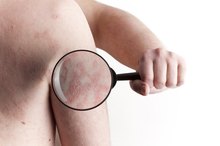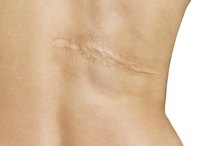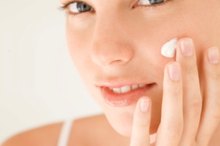What does fact checked mean?
At Healthfully, we strive to deliver objective content that is accurate and up-to-date. Our team periodically reviews articles in order to ensure content quality. The sources cited below consist of evidence from peer-reviewed journals, prominent medical organizations, academic associations, and government data.
The information contained on this site is for informational purposes only, and should not be used as a substitute for the advice of a professional health care provider. Please check with the appropriate physician regarding health questions and concerns. Although we strive to deliver accurate and up-to-date information, no guarantee to that effect is made.
Creams for Hard Skin Removal
Hard skin typically occurs on your hands, feet or other areas prone to friction, dryness and irritation. These areas of hard skin may be painless—as is usually the case with calluses—or they may be painful and inflamed. You can reduce or remove hard skin by avoiding sources of pressure and friction, removing areas of thickened skin and applying medicated creams and moisturizers to those areas.
Types
Salicylic acid creams are the most commonly used in the treatment of corns and calluses. These creams are available in over-the-counter and prescription strength formulas and can effectively soften and remove areas of hard, thickened skin when you use them consistently over long periods. Creams containing lactic acid or urea are also beneficial in the treatment of hard skin, according to the New Zealand Dermatological Society 1. Urea creams offer multiple benefits; they soften hard skin, attract and retain moisture and increase the penetration of other medications.
- Salicylic acid creams are the most commonly used in the treatment of corns and calluses.
- Creams containing lactic acid or urea are also beneficial in the treatment of hard skin, according to the New Zealand Dermatological Society 1.
Use
How to Remove Hard Skin From Feet
Learn More
Read the instructions that came with your cream carefully before using it and discuss any concerns you have with your doctor or pharmacist. Apply cream containing salicylic acid directly to the area of hard skin and rub it in gently. Drugs.com recommends soaking the affected area in warm water for five minutes prior to applying the cream to help soften the skin 23. Continue using the cream once or twice each day -- according to the manufacturer's instructions -- for up to two weeks. If you are using a cream containing urea with or without salicylic acid, apply the cream directly to hard skin as directed by your doctor 2.
Function
Salicylic acid softens a skin protein called keratin and works to promote the shedding of the skin's outer layer. Urea creams work by breaking down hard, dead skin cells. Urea may also help the skin draw in and retain moisture to treat hard skin resulting from dryness. Lactic acid helps treat hard skin by increasing its moisture level. This makes the skin more pliable, softer and more receptive to other treatments.
- Salicylic acid softens a skin protein called keratin and works to promote the shedding of the skin's outer layer.
Side Effects
How to Get Rid of Psoriasis & Eczema
Learn More
Side effects of creams with salicylic acid include skin irritation, dryness, peeling, and redness. Children may be at higher risk for side effects due to an increased absorption rate of salicylic acid through the skin, according to Drugs.com 234. Overdose may cause diarrhea, confusion, rapid breathing, headache, nausea, drowsiness, stomach pain, lightheadedness, ringing in the ears or hearing loss. Report these symptoms to a medical professional immediately. Common side effects of urea creams include skin burning, irritation and itching.
- Side effects of creams with salicylic acid include skin irritation, dryness, peeling, and redness.
- Children may be at higher risk for side effects due to an increased absorption rate of salicylic acid through the skin, according to Drugs.com 2.
Considerations
Creams for hard skin are only a temporary solution, according to Podiatry Network. It is necessary to uncover and treat the underlying cause of the hard skin to prevent symptoms from recurring. Wearing shoes that fit properly, correcting structural abnormalities that may be contributing to hard skin and regularly using a pumice stone and moisturizer on affected areas are important factors in both preventing and treating hard skin.
- Creams for hard skin are only a temporary solution, according to Podiatry Network.
- It is necessary to uncover and treat the underlying cause of the hard skin to prevent symptoms from recurring.
Warnings
Salicylic acid and other creams for hard skin removal may not be suitable for those with diabetes, blood vessel disease, skin irritation or inflammation, chicken pox, kidney or liver disease, or influenza. Use of salicylic acid cream may also increase the risk of Reyes syndrome in children. Additionally, do not use abrasive skin cleansers, alcohol-based products or topical acne medications on areas being treated with salicylic acid creams 4. Doing so can significantly increase skin irritation and other side effects, according to Drugs.com 2.
Related Articles
References
- New Zealand Dermatological Society: Urea
- Drugs.com: Urea Cream
- Drugs.com: Lactic Acid Cream
- Drugs.com: Salicylic Acid: Topical Route
- Harvard Health: Finding Relief From Calluses and Corns
- The American Journal of Managed Care. Overview of atopic dermatitis. Published June 19, 2017.
- McLean WH. The allergy gene: how a mutation in a skin protein revealed a link between eczema and asthma. F1000 Med Rep. 2011;3:2. Published 2011 Jan 14. doi:10.3410/M3-2
- Tang SC, Yang JH. Dual effects of alpha-hydroxy acids on the skin. Molecules. 2018;23(4):863. doi:10.3390/molecules23040863
- Spada F, Barnes TM, Greive KA. Skin hydration is significantly increased by a cream formulated to mimic the skin's own natural moisturizing systems. Clin Cosmet Investig Dermatol. 2018;11:491–497. doi:10.2147/CCID.S177697
- Winterton S, Daly S. What is the best treatment for plantar warts? Evidence-Based Practice. 2018 Jun;21(6):12. doi:10.1097/01.EBP.0000545158.92446.cd
- Ockenfels HM. Therapeutic management of cutaneous and genital warts. J Dtsch Dermatol Ges. 2016;14(9):892-899. doi:10.1111/ddg.12838
- Simon D, Nobbe S, Nägeli M, et al. Short- and long-term effects of two emollients on itching and skin restoration in xerotic eczema. Dermatol Ther. 2018;31(6):e12692. doi:10.1111/dth.12692
- van Zuuren EJ, Fedorowicz Z, Christensen R, Lavrijsen A, Arents BWM. Emollients and moisturisers for eczema. Cochrane Database Syst Rev. 2017;2(2):CD012119. Published 2017 Feb 6. doi:10.1002/14651858.CD012119.pub2
- Cleveland Clinic. Understanding the ingredients in skin care products. Updated March 1, 2015.
- Pan M, Heinecke G, Bernardo S, Tsui C, Levitt J. Urea: a comprehensive review of the clinical literature. Dermatol Online J. 2013;19(11):20392. Published 2013 Nov 15.
- Jacobi A, Mayer A, Augustin M. Keratolytics and emollients and their role in the therapy of psoriasis: a systematic review. Dermatol Ther (Heidelb). 2015;5(1):1-18. doi:10.1007/s13555-015-0068-3
- Bhanot A, Huntley A, Ridd MJ. Adverse events from emollient use in eczema: A restricted review of published data. Dermatol Ther (Heidelb). 2019;9(2):193-208. doi:10.1007/s13555-019-0284-3
- Ademola J, Frazier C, Kim SJ, Theaux C, Saudez X. Clinical evaluation of 40% urea and 12% ammonium lactate in the treatment of xerosis. Am J Clin Dermatol. 2002;3(3):217-222. doi:10.2165/00128071-200203030-00007
- National Eczema Association. Controlling eczema by moisturizing.
- U.S. Food and Drug Administration. Alpha hydroxy acids. Updated May 7, 2019.
Writer Bio
Sandra Ketcham has nearly two decades of experience writing and editing for major websites and magazines. Her work appears in numerous web and print publications, including "The Atlanta Journal-Constitution," "The Tampa Bay Times," Visit Florida, "USA Today," AOL's Gadling and "Kraze Magazine."









